1124201
Mid-19th Century Autograph Album
President Franklin Pierce
33rd United States Congress
Confederate Government Leaders ‒ Jefferson Davis, Alexander H. Stephens, and Others
Union and Confederate Generals
Giants in Texas History ‒ Sam Houston, Thomas Jefferson Rusk, and George Washington Smyth
Chief Justice Salmon P. Chase
Scans of representative pages:
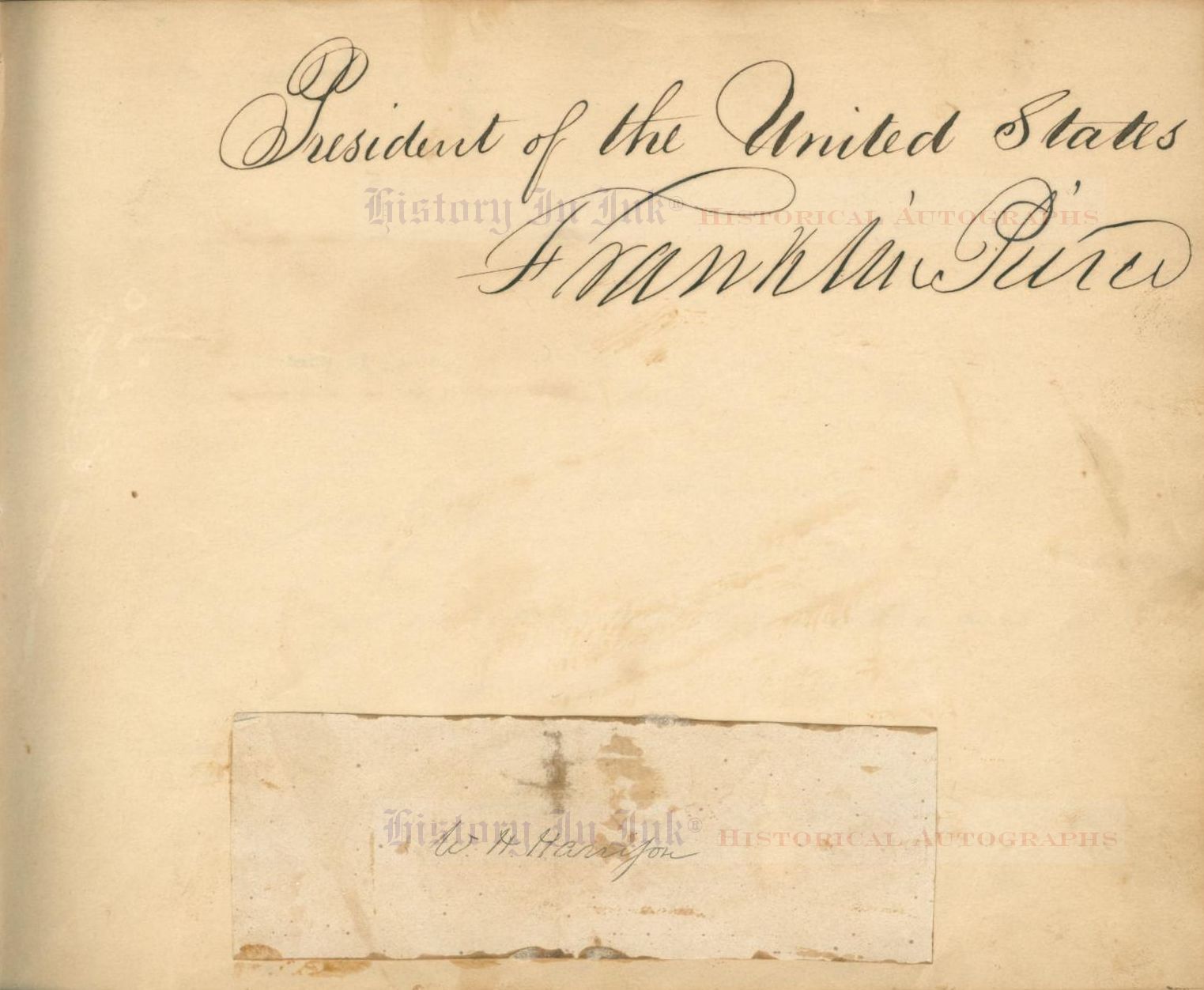
Franklin Pierce
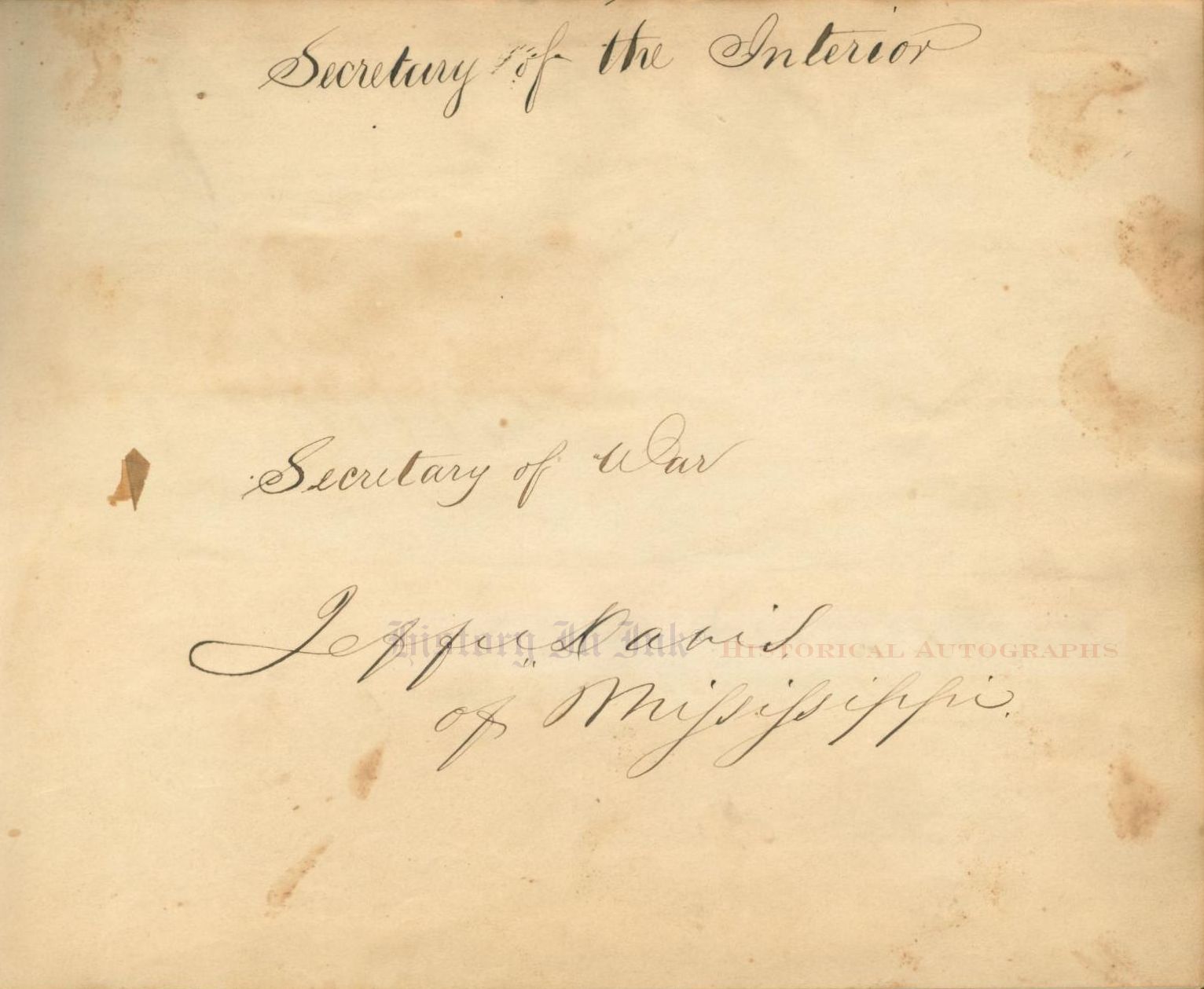
Jefferson Davis
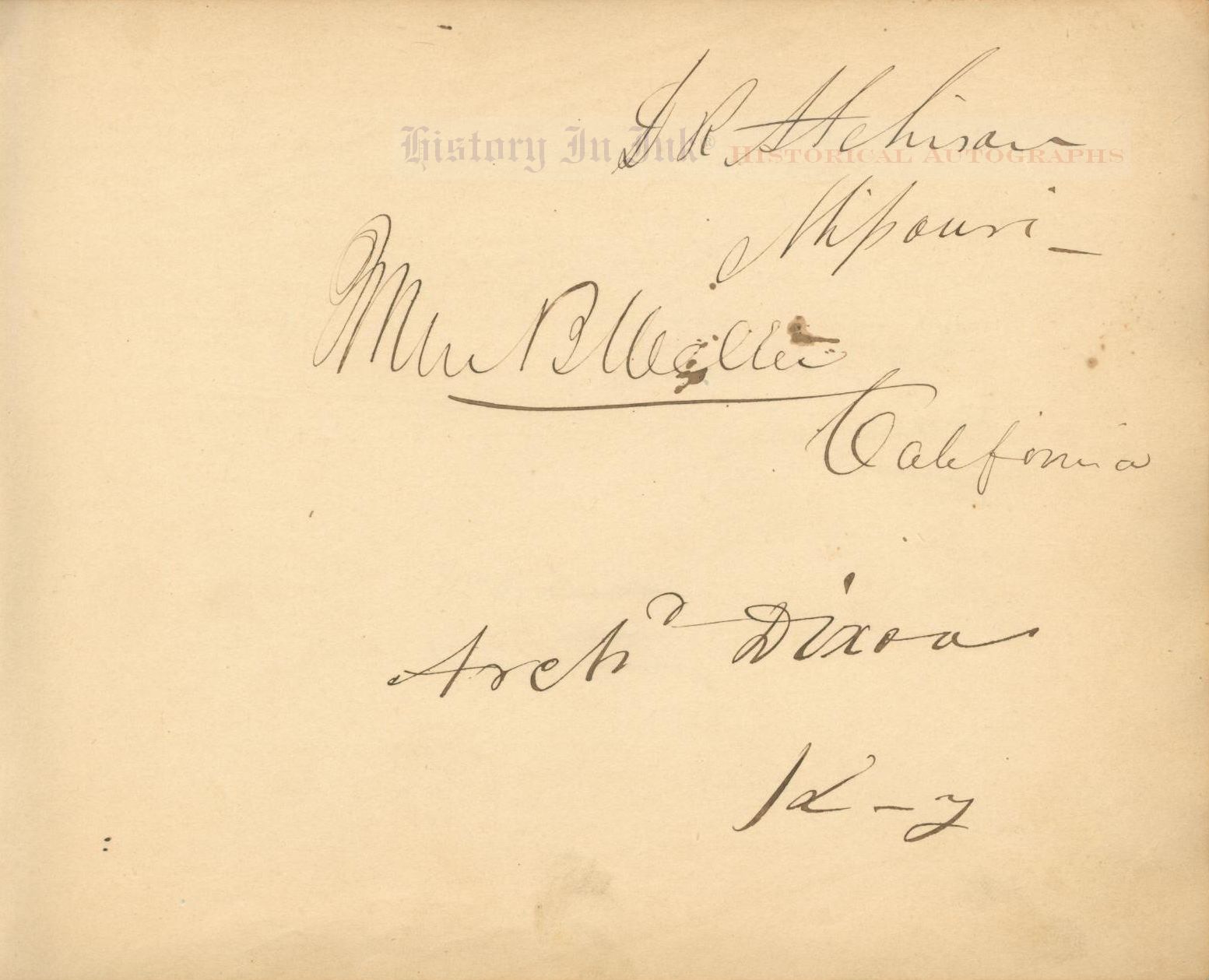
David Rice Atchison
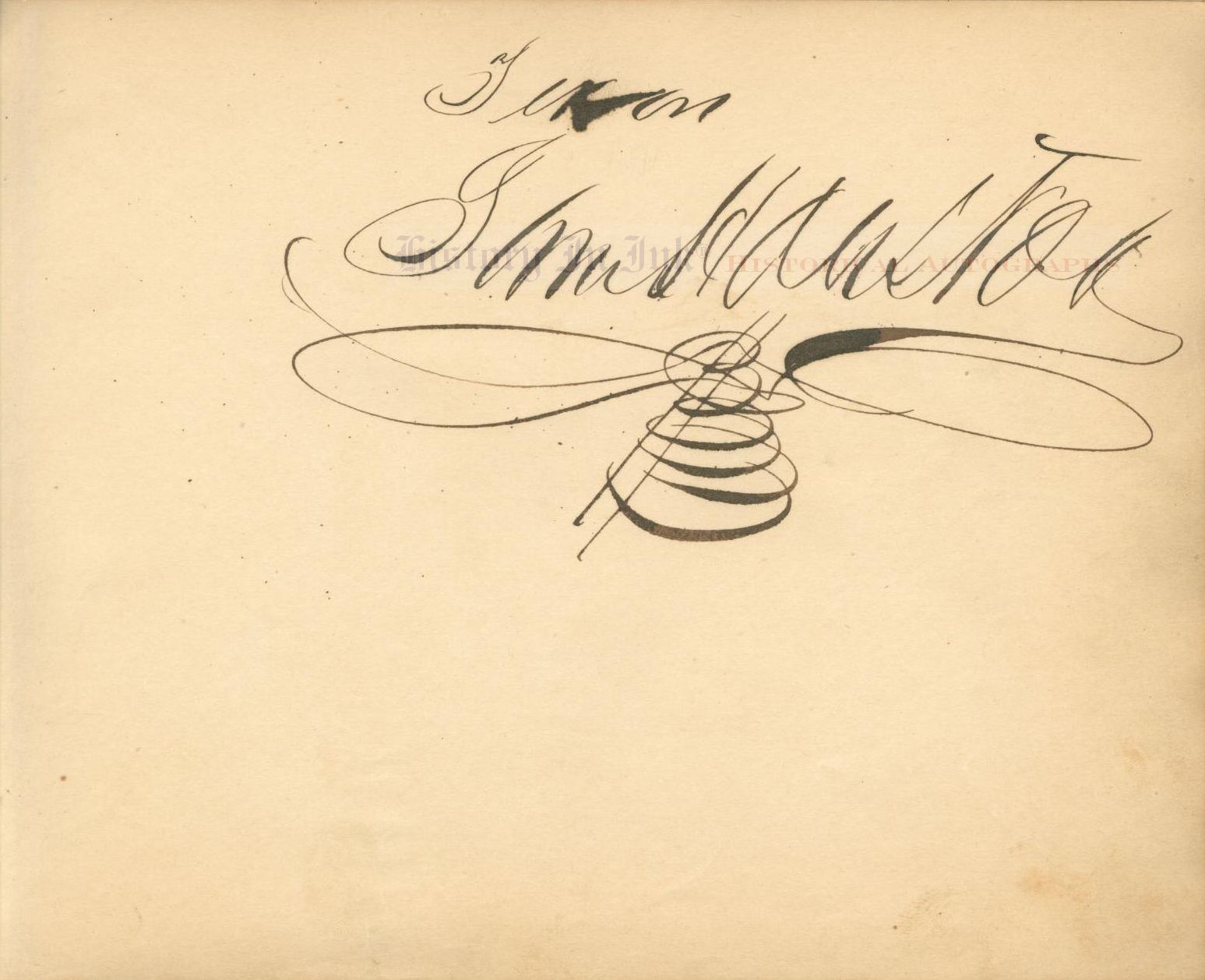
Sam Houston
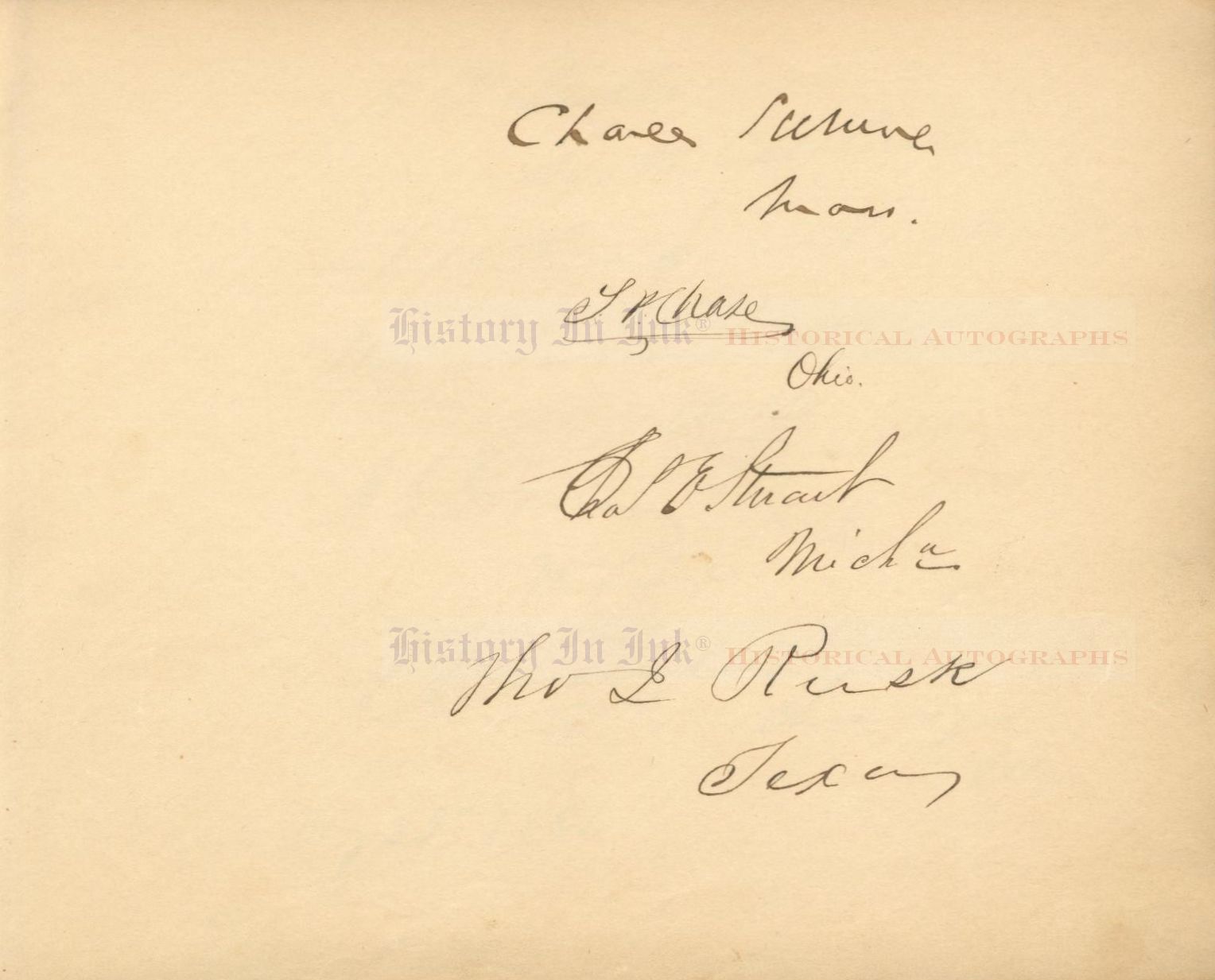
Charles Sumner
Salmon P. Chase
Thomas Jefferson Rusk
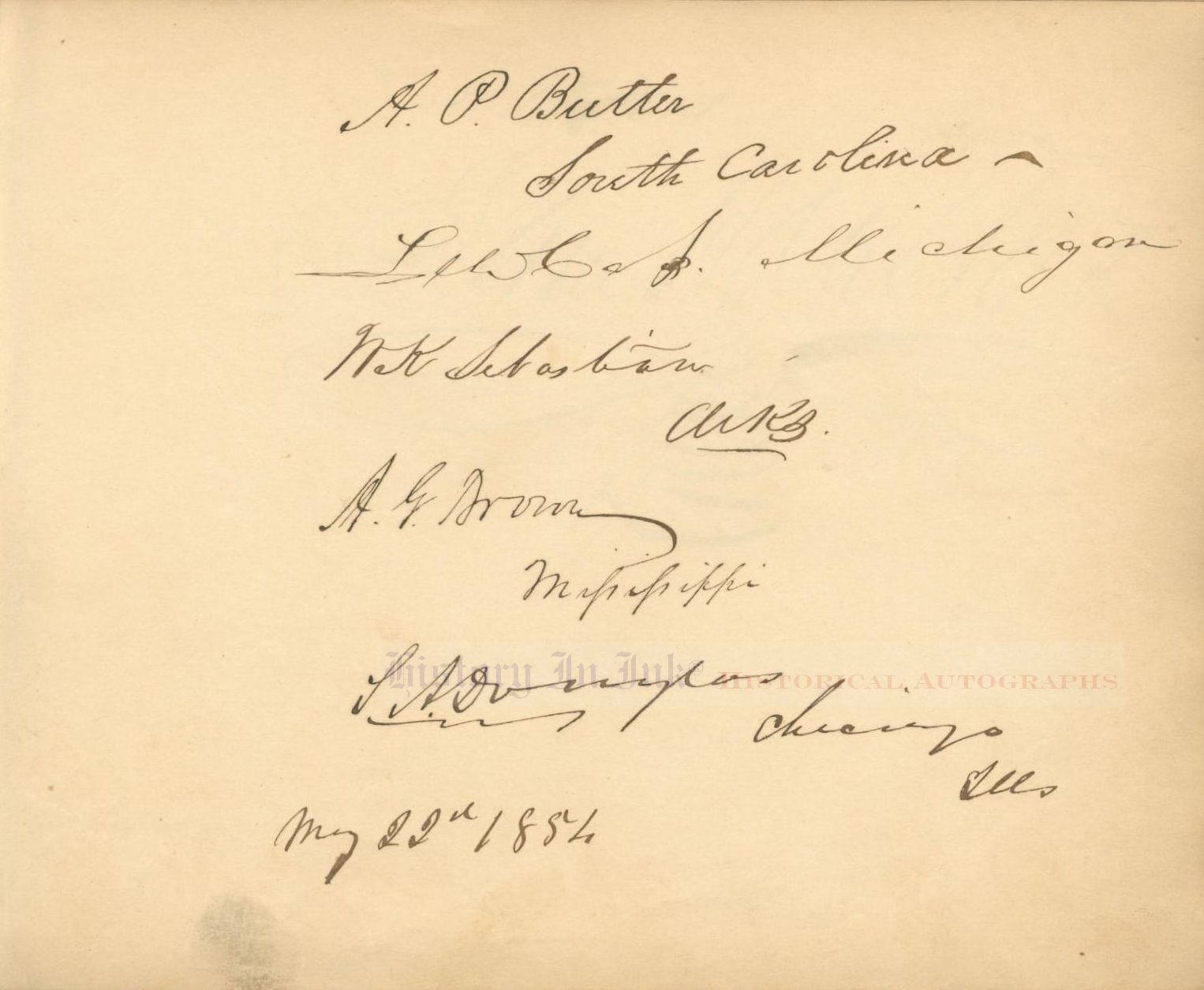
Stephen A. Douglas
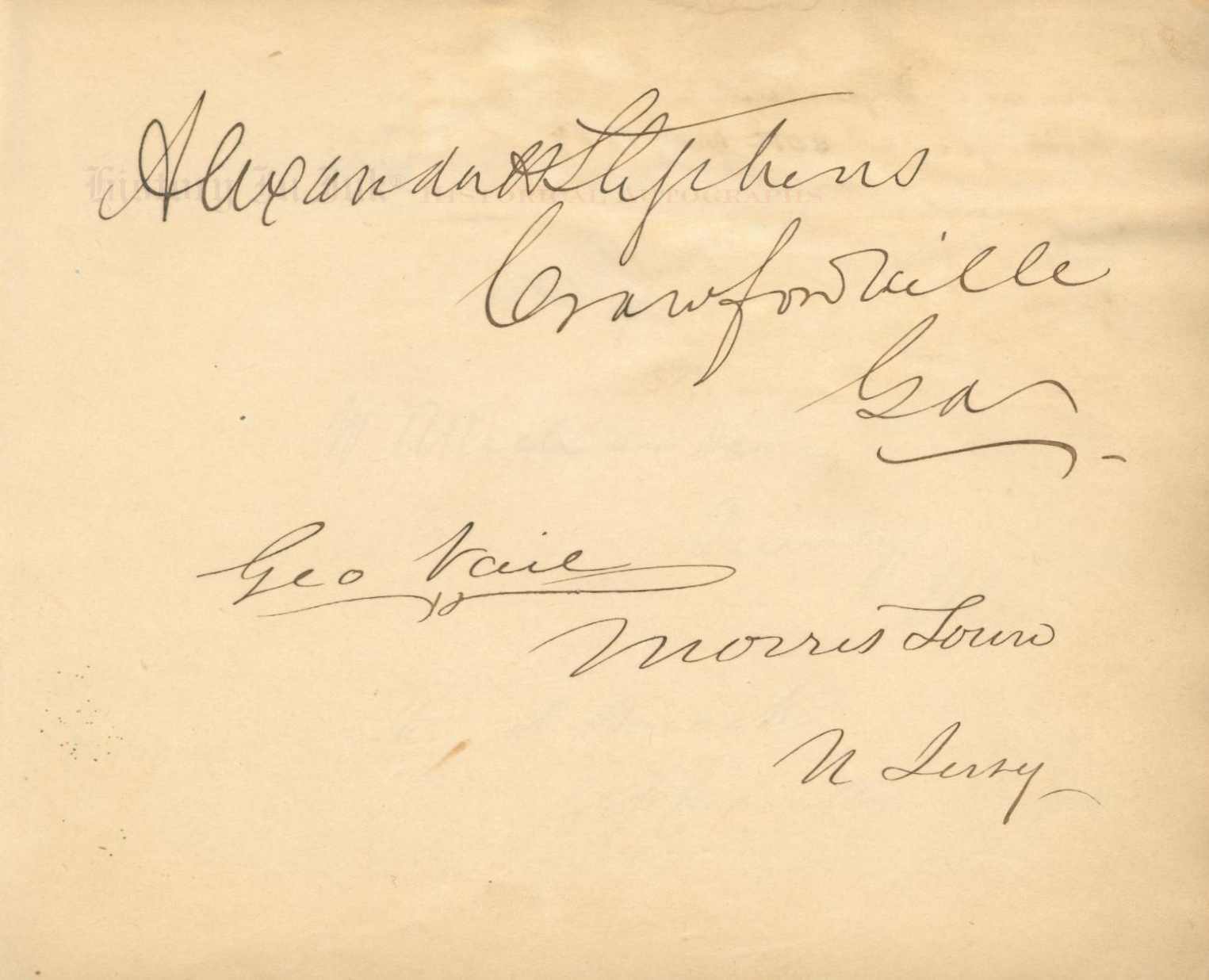
Alexander Stephens
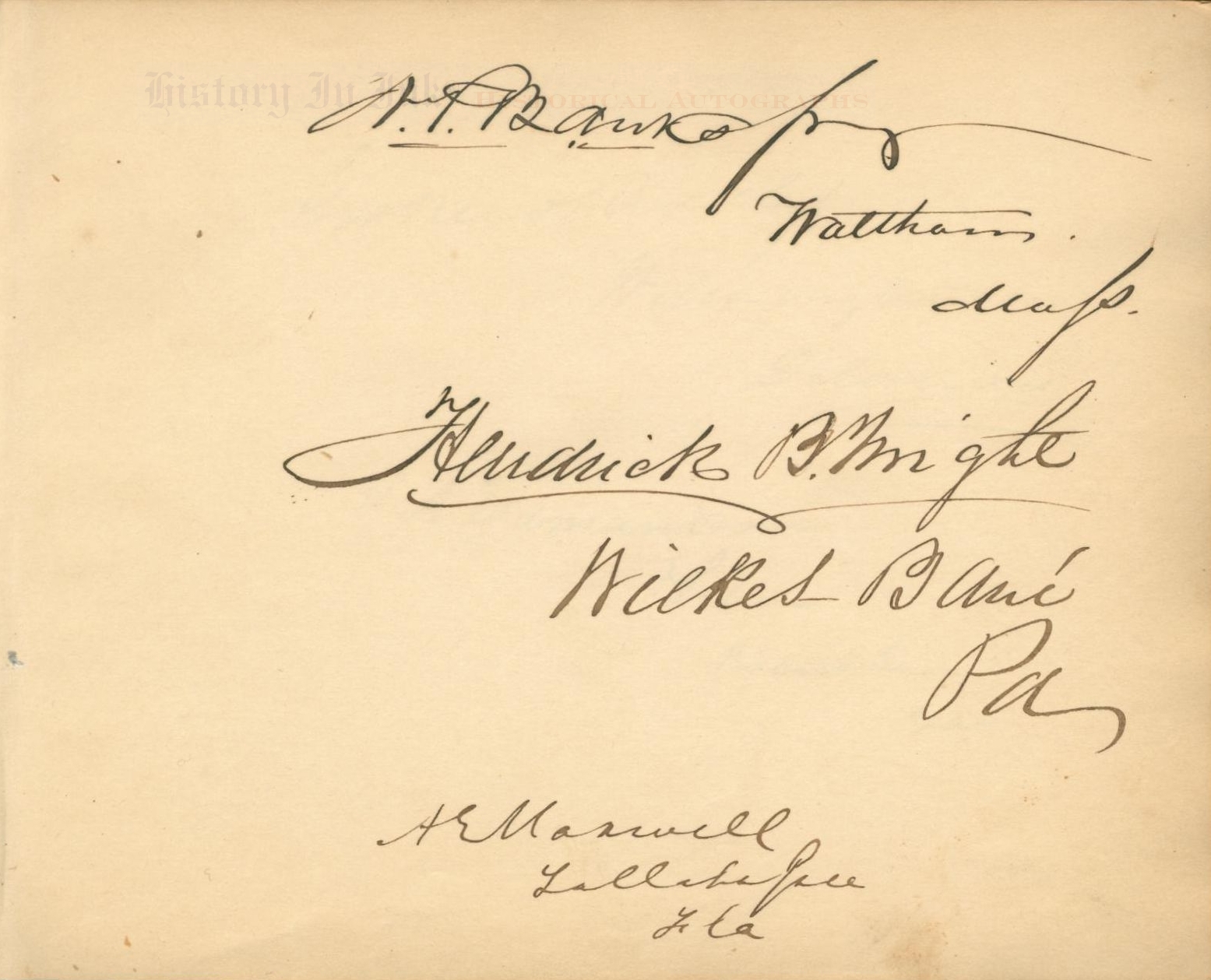
Nathaniel P. Banks
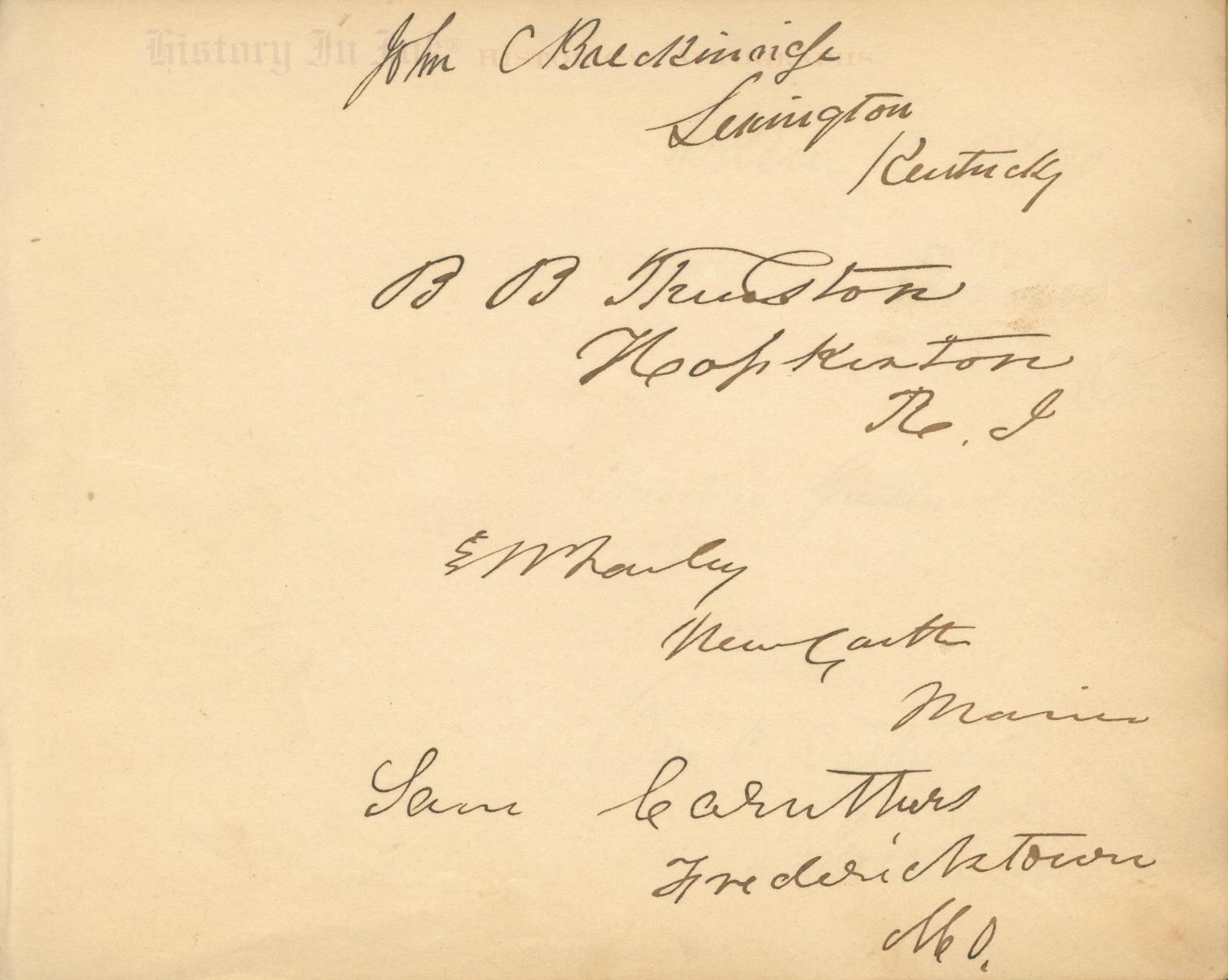
John C. Breckinridge
Mid-19th Century Autograph Album
This excellent album, from a turning-point era in American history as the country debated the slavery issue, comprises not only the American political elite of the mid-1800s but also many of the prominent personalities of the Civil War, including a number of members of the Confederate government, and of the Texas Republic. Based on the dates of congressional service of most of those who signed the album, it appears to date principally from the 33rd Congress, which sat from March 4, 1853, to March 4, 1855. A dedication at the front is dated June 13, 1854, at Washington, D.C.
The album begins with the signature of President Franklin Pierce, below which a facsimile signature of President William Henry Harrison has been tipped onto the bottom of the page. The album also contains the signature of David Rice Atchison, who some claim served as President for one day on Sunday, March 4, 1849, when Zachary Taylor refused to be inaugurated on a Sunday.
It also contains the signatures of a number of members of Pierceʼs cabinet, the most recognizable of whom was the Secretary of War, Jefferson Davis, who became the President of the Confederate States of America. Other prominent members of the Confederate government who appear in the album are Alexander H. Stephens, Vice President; Robert Tooms, the first Confederate Secretary of State; Judah P. Benjamin, who served variously as the Confederate Attorney General, Secretary of War, and Secretary of State; John C. Breckinridge, Secretary of War; Robert M. Hunter, second Confederate Secretary of State; Stephen R. Mallory, Secretary of the Navy; Thomas S. Bocock, Speaker of the Confederate House of Representatives; James L. Orr, one of three commissioners sent to Washington, D.C., to negotiate surrender of federal property to South Carolina, the failure of which led to the bombardment of Fort Sumter in Charleston harbor and the outbreak of the Civil War; and John Slidell, one of the two Confederate diplomats involved in the Trent affair. There are a number of others who served in the Confederate Congress, including Clement C. Clay, Jr., whose picture appears on the fourth issue of the Confederate $1 bill.
The album also contains three giants in Texas history who signed the Texas Declaration of Independence: Sam Houston, who served twice as President of the Republic of Texas, 1836–1838 and 1841–1844, and later as Governor of Texas; Thomas Jefferson Rusk, who chaired the committee that revised the Constitution of the Republic of Texas; and George Washington Smyth, who signed both the Texas Declaration of Independence and the constitution of the Republic of Texas. Houston led the troops that defeated the Mexican forces of General Antonio López de Santa Anna at the Battle of San Jacinto on April 21, 1836. Rusk participated with bravery in that battle and later held several positions in the government of the Republic of Texas: as a brigadier general and commander-in-chief of the Army, 1836; as the first Secretary of War, 1836; as a member of the Second Congress of the Republic, 1837–1838; and as Chief Justice of the Supreme Court, 1838–1840.
Also included are Illinois Senator Stephen A. Douglas, who defeated Abraham Lincoln for the Senate in 1858 and was the Democratic nominee for president against him in 1860, and Tennessee Senator John Bell, the Constitutional Union Party presidential nominee opposing Lincoln in 1860.
Other prominent names in this album include Salmon P. Chase, the Ohio Senator who served as Lincolnʼs Secretary of the Treasury and later was his appointee as Chief Justice of the United States; Gerritt Smith, a staunch abolitionist who was one of the Secret Six who financed John Brown's raid on the arsenal at Harperʼs Ferry; Union Major General Nathaniel P. Banks; Confederate Brigadier Generals Robert Toombs and Thomas L. Clingman; and two founders of the Republican Party, Joshua R. Giddings and Israel Washburn, Jr.
Tipped onto pages in the back are signatures of a number of politicians, including governors and both state and federal legislators, and people who appear to be family and friends of the collectorv. There are, though, some other prominent people as well: J. N. Bonaparte, likely Jérôme Napoléon Bonaparte, chairman of the Maryland Agricultural Society and the nephew of Napoleon I of France, and Horace Greeley, the influential editor of the New York Tribune.
Altogether, this album contains the signatures of 42 Senators and 72 Representatives from the 33rd Congress.
The album itself is fragile. The covers are loose; most of the pages are bound, although a few are loose, and the binding is split. The signatures, however, are all fine to extra fine.
Here is a list of all of the Administration and Congressional signers, by page, with the more prominent signers shown in blue:
Franklin Pierce
14th President of the United States.
_____________
William L. Marcy
Secretary of State, 1853–1857.
John M. Clayton
Secretary of State, 1849–1850; Senator from Delaware, 1829–1836, 1845–1849, 1853–1856.
James Guthrie
Secretary of the Treasury, 1853–1857; Senator from Kentucky, 1865–1868.
_____________
Jefferson Davis
Secretary of War, 1853–1857; Senator from Mississippi, 1847–1851; President of the Confederate States of America, 1861–1865.
_____________
J. C. Dobbin
Secretary of the Navy, 1853–1857; Representative from North Carolina, 1845–1847.
James Campbell
Postmaster General, 1853–1857.
_____________
Caleb Cushing
Attorney General, 1853–1857; Representative from Massachusetts, 1835–1843.
I. S. Gardner
This person's identity is unknown. The signature includes the note “Penn Yan, New York, R.D. 9,” suggesting that Gardner was the representative from New York's 9th District. The congressional biographical directory, however, shows no person by this name in Congress.
_____________
Robert W. Johnson
Senator from Arkansas, 1853–1861; Representative from Arkansas, 1847–1853
Isaac Pigeon Walker
Senator from Wisconsin, 1848–1855.
John Burton Thompson
Senator from Kentucky, 1853–1859.
_____________
Augustus C. Dodge
Senator from Iowa, 1848–1855; one of the first set of Senators to represent Iowa.
Henry Dodge
Senator from Wisconsin, 1848–1857; Major General, Missouri Militia, War of 1812; veteran of the Black Hawk War; Governor of Wisconsin Territory. Dodge was the father of Augustus C. Dodge (above), the only father-son pair ever to serve together in the United States Senate.
Jared W. Williams
Senator from New Hampshire, 1853–1854.
_____________
Isaac Toucey
Senator from Connecticut, 1851–1856; Representative from Connecticut, 1835–1838; Attorney General, 1848–1849; Secretary of the Navy, 1857–1861.
Charles T. James
Senator from Rhode Island, 1851–1857.
Clement C. Clay, Jr.
Senator from Alabama, 1853–1861; Confederate Senator from Alabama, 1862–1864. Clay appears on the fourth issue of the Confederate $1 bill.
Judah P. Benjamin
Senator from Louisiana, 1853–1860. Benjamin also served as Confederate Attorney General, 1861; Confederate Secretary of War, 1861–1862; and Confederate Secretary of State, 1861–1865. Benjamin appears on the Confederate $2 bill.
John Bell
Senator from Tennessee; Representative from Tennessee, 1827–1841; Speaker of the House of Representatives, 1834–1835; Secretary of War, 1841. As the nominee of the Constitutional Union Party, Bell was one of the three candidates whom Abraham Lincoln defeated for the presidency in 1860.
_____________
Robert Toombs
Senator from Georgia, 1853–1861; first Confederate Secretary of State, 1861; Confederate brigadier general, wounded in the Battle of Antietam.
Hamilton Fish
Senator from New York; Secretary of State, 1869–1877, considered one of the best Secretaries of State in American history; Governor of New York, 1849–1850.
Benjamin F. Wade
Senator from Ohio, 1851–1869. Wade was President Pro Tempore of the Senate during the impeachment trial of President Andrew Johnson and would have become President had Johnson been convicted; there is considerable sentiment that Johnson was acquitted—by one vote—because of concern that the extremely Radical Republican Wade not become President.
_____________
Josiah J. Evans
Senator from South Carolina, 1853–1858.
Philip Allen
Senator from Rhode Island, 1853–1859; Governor of Rhode Island, 1851–1853.
John Slidell
Senator from Louisiana, 1853–1861; Confederate Commissioner to France and one of two Confederate diplomats involved in the Trent Affair.
_____________
Stephen R. Mallory
Senator from Florida, 1850–1861; Confederate Secretary of the Navy, 1861–1865; his idea of incorporating armor into ship warship construction became standard among world navies.
John Pettit
Senator from Indiana, 1853–1855. Pettit, a Democrat, argued in favor of extending slavery into Kansas, asserting that Jefferson's idea, asserted in the Declaration of Independence, that “all men are created equal" was not a "self-evident truth" but instead was “nothing more to me than a self-evident lie.” The debate that his inflammatory comments stirred rekindled Abraham Lincoln's interest in national politics.
James C. Jones
Senator from Tennessee, 1851–1857; Governor of Tennessee, 1841–1845. Jones defeated James K. Polk twice for the governorship of Tennessee and was the first native Tennessean elected Governor.
_____________
David Rice Atchison
Senator from Missouri, 1844–1855; President Pro Tempore of the Senate, 1846–1849, 1852–1854. Some claim that Atchison was President of the United States for one day, Sunday, March 4, 1849. Zachary Taylor, who had been elected President, refused to be sworn into office on a Sunday, and consequently the incoming Vice President, Millard Fillmore, likewise was not sworn in. Because President James K. Polk's term expired, Atchison, As President Pro Tempore of the Senate, would have been the next in line of presidential succession. Atchison himself never claimed the office.
John B. Weller
Senator from California, 1852–1857; Governor of California, 1858–1860.
Archibald Dixon
Senator from Kentucky, 1852–1855.
_____________
Jackson Morton
Senator from Florida, 1849–1855. Morton was also a signer of the Confederate Provisional Constitution and the Confederate Constitution and served in the Confederate Congress, one of only two men who served in both the United States Congress and the Confederate Congress.
Thomas Pratt
Senator from Maryland, 1850–1857; Governor of Maryland, 1845–1848.
William C. Dawson
Senator from Georgia, 1849–1855; Representative from Georgia, 1836–1841.
_____________
James Alfred Pearce
Senator from Maryland, 1849–1862; Representative from Maryland, 1835–1839.
Solomon Foot
Senator from Vermont, 1851–1866; President Pro Tempore of the Senate, 1861–1864.
Moses Norris, Jr.
Senator from New Hampshire, 1849–1855.
_____________
Robert M. T. Hunter
Senator from Virginia, 1847–1861; Speaker of the House of Representatives, 1839–1841; second Confederate Secretary of State, 1861–1862.
Richard Brodhead
Senator from Pennsylvania, 1851–1857; Representative from Pennsylvania, 1843–1849.
James A. Bayard, Jr.
Senator from Delaware, 1851–1864, 1867–1869. Bayard resigned from the Senate after refusing to swear loyalty to the Union during the Civil War. He re-entered the Senate in 1867 and voted to acquit President Andrew Johnson at his impeachment trial.
_____________
Charles Sumner
Senator from Massachusetts, 1851–1874. A specialist in foreign affairs, Sumner worked closely with President Abraham Lincoln to keep England and France from intervening on the side of the Confederacy during the Civil War. A vocal abolitionist, Sumner was a chief leader of the Radical Republicans in the Senate during Reconstruction.
Salmon P. Chase
Senator from Ohio, 1849–1855; Governor of Ohio, 1856–1860; Lincoln's Secretary of the Treasury, 1861–1864; Chief Justice of the United States, 1864–1873.
Charles E. Stuart
Senator from Michigan, 1853–1859.
Thomas J. Rusk
Senator from Texas, 1846–1857; President Pro Tempore of the Senate, 1857. Rusk signed the Texas Declaration of Independence and chaired the committee that revised the Constitution of the Republic of Texas. He participated with bravery in the defeat of Mexican General Antonio López de Santa Anna at the Battle of San Jacinto and later served in a number of positions in the Republic of Texas: as a brigadier general and commander-in-chief of the Army, 1836; as the first Secretary of War, 1836; as a member of the Second Congress of the Republic, 1837–1838; and as Chief Justice of the Supreme Court, 1838–1840.
_____________
Andrew P. Butler
Senator from South Carolina, 1846–1857. Butler was the subject of Massachusetts Senator Charles Sumner's vitriolic diatribe against Butler personally and his support for the institution of slavery. One of Butler's relatives, South Carolina Representative Preston Brooks, attacked Sumner on the Senate floor with a cane and continued to beat him as he lay defenseless on the floor, while another South Carolina Representative used a pistol to keep other Senators from intervening.
Lewis Cass
Senator from Michigan, 1845–1848, 1849–1857; President Pro Tempore of the Senate, 1854; Secretary of War, 1831–1836; United States Ambassador to France, 1836–1842; Secretary of State, 1857–1860.
William K. Sebastian
Senator from Arkansas, 1848–1861.
Albert Gallatin Brown
Senator from Mississippi, 1848–1861; Governor of Mississippi, 1844–1848; Confederate States Senator from Mississippi, 1862–1865. Along with Florida's Jackson Morton, Brown is one of only two men who served in both the United States Congress and the Confederate Congress.
Stephen A. Douglas
Senator from Illinois, 1847–1861; Representative from Illinois, 1843–1847. The Illinois legislature selected Douglas over Abraham Lincoln for the Senate in 1858 following the famed Lincoln–Douglas debates. Two years later, Douglas was the nominee of the northern Democratic party for President but lost the critical election to Lincoln.
_____________
Sam Houston
Senator from Texas, 1846–1859; Governor of Tennessee, 1827–1829; President of the Republic of Texas, 1836–1838, 1841–1844; Governor of Texas, 1859–1861. As Governor of Texas, Houston acquiesced in ouster from office rather than take an oath to support the Confederacy after a Texas convention had voted to secede from the Union.
_____________
Linn Boyd
Representative from Kentucky, 1835–1837, 1839–1855; Speaker of the House of Representatives, 1851–1855.
_____________
Charles Hughes
Representative from New York, 1853–1855.
William M. Tweed
Representative from New York, 1853–1855. “Boss" Tweed was the boss of Tammany Hall, the New York Democratic political machine that virtually controlled New York City and New York State during the late 19th Century.
Solomon G. Haven
Representative from New York, 1851–1857.
_____________
Francis B. Cutting
Representative from New York, 1853–1855.
Gerrit Smith
Representative from New York, 1853–1854. Smith was a staunch abolitionist. He was a member of the Secret Six who financially supported John Brown's raid on Harper's Ferry, and he was elected to the House of Representatives in 1852 as a Free-Soiler. He was a three-time presidential candidate: In 1848, he was nominated by the remnant of the Liberty Party that had not been absorbed into the Free Soil Party and was also nominated by an “Industrial Congress" at Philadelphia; and in 1856 he was the nominee of the “Land Reformers."
George Hastings
Representative from New York, 1853–1855.
Jared V. Peck
Representative from New York, 1853–1855.
_____________
Reuben E. Fenton
Representative from New York, 1853–1855, 1857–1865; Governor of New York, 1865–1868; Senator from New York, 1869–1875.
Theodoric R. Westbrook
Representative from New York, 1853–1855.
Benjamin Pringle
Representative from New York, 1853–1857; appointed by President Lincoln as a judge of the Court of Arbitration in Cape Town (now South Africa) under the Treaty of April 7, 1862, for the suppression of slave trade.
_____________
Thomas T. Flagler
Representative from New York, 1853–1857.
Hiram Wallbridge
Representative from New York, 1853–1855.
_____________
Davis Carpenter
Representative from New York, 1853–1855.
Caleb Lyon
Representative from New York, 1853–1855; appointed by President Abraham Lincoln as the second Governor of Idaho Territory, 1864–1865. Lyon has signed a poem that appears to be written for him in another hand.
_____________
William Murray
Representative from New York, 1851–1855. Murray was instrumental in the organization of the Republican Party in 1856.
Peter Rowe
Representative from New York, 1853–1855.
Gilbert Dean
Representative from New York, 1851–1854.
_____________
Andrew Oliver
Representative from New York, 1853–1857.
Edwin B. Morgan
Representative from New York, 1853–1859. Morgan was also the first president of Wells Fargo & Company, the founder of the United States Express Company, a director of American Express Company, and an original shareholder of The New York Times. He served his three terms in Congress as a Whig, as an Opposition Party member, and as a Republican, respectively.
Russell Sage
Representative from New York, 1853–1857. A financier who amassed a fortune, Sage invested heavily in western railroads, notably the Chicago, Milwaukee & St. Paul Railway. He was associated with Jay Gould in the management of a number of railroads and was a director of the Wabash Railway, the Missouri Pacific Railroad, the Missouri-Kansas-Texas Railroad, the Delaware, Lackawanna & Western Railroad, the St. Louis-San Francisco Railway, and the Union Pacific Railroad, which took part in building the first transcontinental railroad.
_____________
Henry Bennett
Representative from New York, 1849–1859.
Bishop Perkins
Representative from New York, 1853–1855.
George A. Simmons
Representative from New York, 1853–1857.
_____________
Charles W. Upham
Representative from Massachusetts, 1853–1855. Upham's wife, Ann, was the sister of Dr. Oliver Wendell Holmes, Sr.
J. Wiley Edmands
Representative from Massachusetts, 1853–1855.
Thomas D. Eliot
Representative from Massachusetts, 1854–1855, 1859–1869.
_____________
William W. Boyce
Representative from South Carolina, 1853–1860. Boyce also represented South Carolina in the Provisional, First, and Second Confederate Congresses from 1861–1865.
William Cullom
Representative from Tennessee, 1851–1855.
David A. Reese
Representative from Georgia, 1853–1855.
_____________
Alexander H. Stephens
Representative from Georgia, 1843–1859, 1873–1882. Stephens was Vice President of the Confederate States of America, 1861–1865, and later served as Governor of Georgia, 1882–1883.
George Vail
Representative from New Jersey, 1853–1857; United States Consul to Glasgow, Scotland, 1858–1861. Vail also served as a judge of the New Jersey Court of Errors and Appeals, New Jersey's highest law court at the time, 1865–1871.
_____________
Charles J. Jenkins
Governor of Georgia, 1865–1868; Union Party Vice Presidential nominee, 1852. This signature is tipped into the album. Jenkins gained notoriety as the author of the Georgia Platform, a proclamation by a special state convention that endorsed the Compromise of 1850. He ran with Daniel Webster on the Union Party ticket in the 1852 presidential election.
_____________
Alfred P. Edgerton
Representative from Ohio, 1851–1855; chairman, United States Civil Service Commission, 1885–1889.
William A. Richardson
Representative from Illinois, 1847–1856, 1861–1863; United States Senator from Illinois, 1863–1865. Richardson was elected to Congress to fill the seat that became vacant when Stephen A. Douglas was elected to the United States Senate. He was later elected to the Senate to fill Douglas's seat there. Richardson also served as governor of the Nebraska territory in 1858.
Thomas S. Bocock
Representative from Virginia, 1847–1861. Bocock, from Appomattox, Virginia, is perhaps better known in his role as the Speaker of the Confederate States House of Representatives from 1862–1865.
_____________
Lewis D. Campbell
Representative from Ohio, 1849–1858, 1871–1873. Campbell was defeated in his bid for reelection in 1858 by Clement L. Vallandigham, who became the leader of the Copperhead faction of the anti-war Democrats in Congress. Campbell was later appointed Envoy Extraordinary and Minister Plenipotentiary to Mexico by President Andrew Johnson in 1866.
George S. Houston
Representative from Alabama, 1841–1859; Governor of Alabama, 1874–1878; United States Senator from Alabama, 1879.
William T. Hamilton
Representative from Maryland, 1849–1855; United States Senator from Maryland, 1869–1875; Governor of Maryland, 1880–1884.
_____________
Thomas B. Florence
Representative from Pennsylvania, 1851–1861.
_____________
Frederick P. Stanton
Representative from Tennessee, 1845–1855. Stanton also served as Governor of the Kansas Territory, 1858–1861.
William H. Witte
Representative from Pennsylvania, 1853–1855.
John Robbins, Jr.
Representative from Pennsylvania, 1849–1855, 1875–1877.
_____________
Nathaniel P. Banks
Representative from Massachusetts, 1853–1857, 1865–1873, 1875–1879, 1889–1891; Speaker of the United States House of Representatives, 1856–1857; Governor of Massachusetts, 1858–1861. Banks was a Union major general during the Civil War.
Hendrick B. Wright
Representative from Pennsylvania, 1853–1855, 1861–1863, 1877–1881.
Augustus E. Maxwell
Representative from Florida, 1853–1857. Maxwell also served as a Confederate States Senator from Florida, 1862–1865.
_____________
George Read Riddle
Representative from Delaware, 1851–1855; United States Senator from Delaware, 1864–1867.
Henry A. Edmondson
Representative from Virginia, 1849–1861. In 1854, Edmondson attempted to attack Ohio Representative Lewis D. Campbell during debates on the Kansas-Nebraska Act, but he was restrained and arrested. Later, he accompanied Preston Brooks when Brooks brutally attacked Massachusetts Senator Charles Sumner on the floor of the United States Senate in 1856. Edmondson resigned from Congress and joined the Confederate Army at the outbreak of the Civil War. He served as a lieutenant colonel in the 54th Virginia Infantry until 1862, when he was assigned to the 25th Virginia Cavalry.
_____________
Harry Hibbard
Representative from New Hampshire, 1849–1855.
Emerson Etheridge
Representative from Tennessee, 1853–1857, 1859–1861.
_____________
John C. Breckenridge
Representative from Kentucky, 1851–1855; Vice President of the United States, 1857–1861; United States Senator from Kentucky, 1861; Confederate States Secretary of War, 1865.
Benjamin B. Thurston
Representative from Rhode Island, 1847–1849, 1851–1857.
E. Wilder Farley
Representative from Maine, 1853–1855.
Samuel Caruthers
Representative from Missouri, 1851–1859.
_____________
Edson B. Olds
Representative from Ohio, 1849–1855. During the Civil War, Olds was a leading member of the Peace Democrats. He was arrested and incarcerated at Fort Lafayette on suspicion that he was discouraging enlistment in the Union Army.
Theodore Gaillard Hunt
Representative from Louisiana, 1853–1855. During the Civil War, Hunt served as a colonel in the 5th Louisiana Regiment. He was later appointed Adjutant General of Louisiana with the rank of brigadier general and remained in active service until the end of the Civil War.
Ben C. Eastman
Representative from Wisconsin, 1851–1855.
_____________
James A. McDougall
Representative from California, 1853–1855; United States Senator from California, 1861–1867.
Joshua R. Giddings
Representative from Ohio, 1838–1859. Giddings was one of the leading anti-slavery members of the United States Congress and led the Free State opposition to further expansion of slavery to the West. He opposed the annexation of Texas, the Mexican War, the 1850 Compromises, and the Kansas-Nebraska Act. He was one of the leading founders of the Republican Party in 1854–1855 and campaigned for both John C. Fremont and Abraham Lincoln. Before the Civil War, he supported the Underground Railroad, helping fugitive slaves to reach freedom.
Israel Washburn, Jr.
Representative from Maine, 1851–1861; Governor of Maine, 1861–1863. Washburn was a founding member of the Republican Party. He called the first meeting in the capital of 30 members of the United States House of Representatives to discuss forming what became the Republican Party. In 1854, he became likely the first politician of his rank to use the term "Republican" in a speech.
_____________
Alfred W. Lamb
Representative from Missouri, 1853–1855.
Thomas L. Clingman
Representative from North Carolina, 1843–1845, 1847–1858; United States Senator from North Carolina, 1858–1861. Clingman was one of ten Senators who refused to resign his seat during the Civil War and was expelled from the Senate in absentia. Clingman served as a brigadier general in the Confederate Army and saw action in the Peninsula Campaign, the Battle of Cold Harbor, the siege of Peterburg, and other battles.
Thomas H. Ruffin
Representative from North Carolina, 1853–1861; Representative from North Carolina to the Provisional Confederate Congress, 1861. Ruffin served as a colonel in the 1st North Carolina Cavalry in the Confederate Army. He was killed in action in Auburn, West Virginia, on October 13, 1863.
_____________
Francis Burton Craige
Representative from North Carolina, 1853–1861. Craige was a delegate to the state secession convention in 1861 and introduced the ordinance of secession in the form in which it was adopted. He served as a delegate to the Provisional Congress of the Confederate States, 1861.
William Montgomery Churchwell
Repesentative from Tennessee, 1851–1855. Churchwell served as a colonel of the Fourth Tennessee Regiment during the Civil War.
_____________
Peter Hansbrough Bell
Representative from Texas, 1853–1857. Bell participated in the Battle of San Jacinto, was assistant adjutant general of the Texas forces, 1837, and inspector general, 1839, and later served as Governor of Texas, 1849–1853.
George Washington Smyth
Representative from Texas, 1853–1855. Smyth was a signer of the Texas Declaration of Independence, 1836, and a signer of the constitution of the Republic of Texas.
_____________
John Perkins, Jr.
Representative from Louisiana 1853–1855. Perkins chaired Louisianaʼs state secession convention and later served in the Confederate States Senate, 1862–1865.
David Tiernan Disney
Representative from Ohio, 1849–1855.
Galusha Aaron Grow
Representative from Pennsylvania 1851–1863, 1894–1903.
_____________
Colin Macrae Ingersoll
Representative from Connecticut, 1851–1855.
Harry Hibbard
[Second signature. See above.]
David Noble Addison
Representative from Michigan, 1853–1855.
_____________
John L. Dawson
Representative from Pennsylvania, 1851–1855.
Thomas Hart Benton
Senator from Missouri, 1821–1851; Representative from Missouri, 1853–1855. Benton was a giant in the Senate, a staunch supporter of Andrew Jackson and of the westward expansion of the United States—the doctrine of Manifest Destiny.
William Montgomery Churchwell
[Second signature. See above.]
_____________
James L. Orr
Representative from South Carolina, 1849–1859; Speaker of the House of Representatives, 1857–1859. Orr was a member of the Confederate secession convention in 1860. He was one of three commissioners sent to Washington, D.C., to negotiate with the federal government for the surrender of federal property to South Carolina, and the failure of the mission led directly to the bombardment of Fort Sumter in Charleston harbor. Orr served as a Confederate Senator from South Carolina, 1862–1865; as Governor of South Carolina, 1865–1868; and as United States Ambassador to Russia under President Ulysses S. Grant, 1872–1873.
William Cullom
[Second signature. See above.]
_____________
Joseph Lane
Delegate and Senator from Oregon, 1851–1861. Lane was the vice presidential running mate of Democrat John C. Breckinridge in the 1860 presidential election.
John M. Bernhisel
Delegate from Territory of Utah, 1851–1859, 1861–1863.
_____________
José Manuel Gallegos
Delegate from Territory of New Mexico, 1853–1856, 1871–1873.
Columbia Lancaster
Delegate from Territory of Washington, 1854–1855.
_____________
Henry M. Rice
Delegate and Senator from Minnesota, 1853–1857, 1858–1863.
Click here to see more Presidential items.
Click here to see more American History items.



